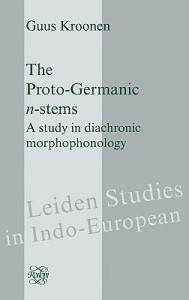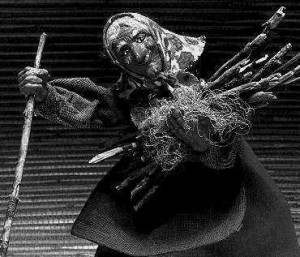 In my dissertation ‘The Proto-Germanic n-stems’, I have presented evidence suggesting that a number of Germanic n-stems retained the root ablaut of the original PIE paradigm. In most cases, this paradigmatic alternation usually is not directly attested, but must nevertheless be reconstructed on the basis of diverging ablaut grades found in the different Germanic daughter languages. Thus, the co-occurrence of for instance Old High German rīdo ‘fever’ < *hrīþan- and rito ‘id.’ < *hridan- points to a Proto-Germanic (PGm.) paradigm nom. *hrīþō, dat. *hrideni continuing Proto-Indo-European (PIE) *kréit-ōn, *krit-én-i. In this particular case, the reality of the ablauting paradigm was further substantiated by Schaffner (Das Vernersche Gesetz, 2001: 549-551). Schaffner noted that the Benedictine monk Notker (950-1022) actually still had it in his Old High German idiolect, the nominative rîdo being accompanied by the dative ríten (the circumflex and acute accents indicate a long and a stressed vowel consecutively). It must be stressed, however, that the bulk of the cases are not as clear-cut, the ablaut only becoming evident by comparing forms from several different Germanic dialects.
In my dissertation ‘The Proto-Germanic n-stems’, I have presented evidence suggesting that a number of Germanic n-stems retained the root ablaut of the original PIE paradigm. In most cases, this paradigmatic alternation usually is not directly attested, but must nevertheless be reconstructed on the basis of diverging ablaut grades found in the different Germanic daughter languages. Thus, the co-occurrence of for instance Old High German rīdo ‘fever’ < *hrīþan- and rito ‘id.’ < *hridan- points to a Proto-Germanic (PGm.) paradigm nom. *hrīþō, dat. *hrideni continuing Proto-Indo-European (PIE) *kréit-ōn, *krit-én-i. In this particular case, the reality of the ablauting paradigm was further substantiated by Schaffner (Das Vernersche Gesetz, 2001: 549-551). Schaffner noted that the Benedictine monk Notker (950-1022) actually still had it in his Old High German idiolect, the nominative rîdo being accompanied by the dative ríten (the circumflex and acute accents indicate a long and a stressed vowel consecutively). It must be stressed, however, that the bulk of the cases are not as clear-cut, the ablaut only becoming evident by comparing forms from several different Germanic dialects.
At collecting further evidence for the preservation of this ablaut, it turned out to be insufficient make use of only the oldest Germanic languages, e.g. Gothic, Old High German and Old Norse. Although these language certainly are more archaic than their middle and modern Germanic descendants, the material tends to be deficient due to the lack of textual sources. It was therefore essential to include modern standard languages plus the pertaining dialects in order to acquire a more complete picture of the paradigmatic ablaut. Thus, the reader will often encounter forms adopted from “periferal” sources such as the Dutch, German and Norwegian dialects, Faroese, Swiss German and the Cimbrian variety of Tyrolian as spoken in Italy. It goes without saying that this decision hugely increased the amount of time required for gathering data. I would therefore also like to express my utmost gratitude to Corinna Scheungraber, who in her highly thorough review of my dissertation draws attention to exactly these efforts.
One particular interesting case in which a modern dialect plays an important role at the reconstruction of different PGm. ablaut grades is presented by the word for ‘hare’. Throughout the Germanic language continuum, this word is attested with an a in the root, cf. OHG haso, G Hase, Du. haas < PGm. *hasan-. The dominance of the a is not complete, however. In my book, I have drawn attention to the West Norwegian form jase (see Grunnmanuskriptet), which in the dialects also occurs as hjase (e.g. in Telemark). According to the known sound changes, these forms must have developed from PGm. *hesan- by the regular breaking of *e into –ja-. It thus appears that these Norwegian dialects prove the existence of an ablauting doublet *hesan- ~ *hasan-. I have accordingly proposed to reconstruct the original paradigm as nom. *hesō, gen. *haznaz, the e-grade being expected in the nominative.
It may seem surprising that the preservation of the Indo-European ablaut has largely been overlooked by the field. The reason for is quite obvious, however. As stated above, the evidence for ablaut can often only be found in the later Germanic languages or dialects rather than in “core languages” such as Old Norse or Gothic. Conversely, unawareness of the existence of the ablaut appears to have caused many a linguist trouble at interpreting the data, as is also noted by Scheungraber. For instance, Bjorvand & Lindeman in their etymological dictionary (Våre arveord, 2000: 347) make a brave attempt at explaining away the e-grade implied by Nw. (h)jase. They do so by assuming a spontaneous j-insertion (j-innskudd) in a further unattested form *hase (standard Nw. has hare < *hazan-, cf. OE hara, E hare). I fail to see, however, how the assumption of two ad hoc‘s would be more elegant than simply taking the data at face value.
 In my view, historical linguistics is all about respecting the data, whether it be from old or modern sources, central or periferal languages, standard languages or dialects. And to be frank, the quality of the data pointing to *hesan- is, in spite of its relatively late providence, rather good, and to my mind leaves no room for speculation. The form (h)jase is attested throughout the West Norwegian dialect area, i.e. from Telemark to Sunnmøre, as can be concluded from Grunnmanuskriptet‘s entry linked to in the above. It further occurs in one of the oldest forms of Norwegian lyric poetry, i.e. in a gamlestev noted down by M.B. Landstad in his famous Norske Folkeviser (1853). The genre dates back to the 13th century, and this time depth is usually also reflected by the use of extremely conservative morphology and vocabulary. Those who still dare to doubt the reliability of the evidence, I invite to listen to Arve Mogen Bergset’s rendering of Kjeringi med staven (‘Woman with a stick’), a traditional folk song recorded in the 19th century. At 35s, a life and kicking ‘hjasi’ comes “høppande forbi”, i.e. hopping happily along, just to say “titi tiri ti”.
In my view, historical linguistics is all about respecting the data, whether it be from old or modern sources, central or periferal languages, standard languages or dialects. And to be frank, the quality of the data pointing to *hesan- is, in spite of its relatively late providence, rather good, and to my mind leaves no room for speculation. The form (h)jase is attested throughout the West Norwegian dialect area, i.e. from Telemark to Sunnmøre, as can be concluded from Grunnmanuskriptet‘s entry linked to in the above. It further occurs in one of the oldest forms of Norwegian lyric poetry, i.e. in a gamlestev noted down by M.B. Landstad in his famous Norske Folkeviser (1853). The genre dates back to the 13th century, and this time depth is usually also reflected by the use of extremely conservative morphology and vocabulary. Those who still dare to doubt the reliability of the evidence, I invite to listen to Arve Mogen Bergset’s rendering of Kjeringi med staven (‘Woman with a stick’), a traditional folk song recorded in the 19th century. At 35s, a life and kicking ‘hjasi’ comes “høppande forbi”, i.e. hopping happily along, just to say “titi tiri ti”.

Dear Guus,
Interesting stuff. But how do you explain E hare (with -r-) vs. Continental and Scandinavian Germanic -s- forms?
Rolf
Seven years late, but I thought the standard explanation was Verner’s law, which shows up in this post as the genitive *haznaz?